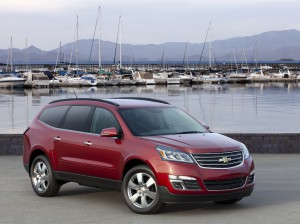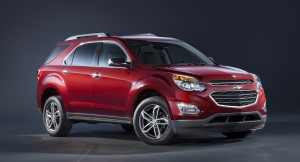
Chevrolet is looking to add another crossover into its line-up after 2017. The newbie will be a short-wheelbase version of the Traverse, reports says.
Chevrolet is looking to exploit the growing demand for crossovers by wedging a fourth one into its lineup between the Traverse and smaller Equinox.
Following the example of several other automakers, the brand will add a yet-to-be-named fourth model sometime after 2017, according to Automotive News.
In order to do so, the Equinox will be downsized a bit and the Traverse will remain a full-size, seven-seat model, reports claim. The new model will, in essence, be a short-wheelbased version of the Traverse, the report said. General Motors officials have declined to comment on the possibility.
The plan gives Chevy more ammunition to keep up with Ford, Honda, Nissan and others who offer a broader range of CUVs and car-based SUVs. The competition for the new model would be the Ford Edge, Toyota Highlander, Honda Pilot, Jeep Grand Cherokee, Hyundai Santa Fe and Nissan Murano. The new model won’t be limited to Chevy, but will also have a Cadillac offering as well.

In order to get a fourth CUV into its portfolio, the next-gen Equinox will be downsized and compete with the Ford Escape.
Crossover sales were up 19.5% in June and are up 13.3% through the first six months of the year, according to Autodata Corp. GM’s CUVs, with the exception of the Buick Enclave, have enjoyed robust sales during that time.
The Trax, Chevrolet’s newest crossover, had sales of 5,971 units for its best month since launch. It helped Chevrolet deliver its best June crossover sales ever. Encore deliveries were up 33% for the small crossover’s 18th consecutive year-over-year sales increase. The Cadillac SRX is up 4.7%, as well as Chevrolet Equinox (20.6%), Chevrolet Traverse (18%) and GMC Acadia (19.2%).
It’s not just GM seeing an uptick in crossovers, the entire industry is making a run with them. Hyundai just rolled out its third-generation Tucson, and Hyundai Motor America President Dave Zuchowski said the Korean automaker believes one reason why its U.S. sales have slowed is due to a hole in its CUV line-up.
(Hyundai counting on crossovers to kick-start momentum. For more, Click Here.)
“We’re not participating in the biggest growth segment in the market,” said the Hyundai CEO during a media drive of the new 2016 Tucson. That’s why the launch of the redesigned crossover is “extremely important in the near future for the brand’s growth.”
Zuchowski said, Hyundai is looking to significantly expand its crossover line-up, with two possible new models in the works, offerings that would bookend the maker’s current utility vehicle line-up.
(Click Here for details the new 2016 Hyundai Tucson.)
According to industry data, car-like crossovers now account for about a third of the new vehicle market – a figure that jumps to 40% when conventional SUVs are included. CUV sales alone have surged from 900,000 to 1.5 million annually during the last five years.
“We are seeing CUV/SUV gains while car sales slow,” said Stephanie Brinley, senior analyst, IHS Automotive. “Contributing to the advance of CUV/SUVs also is that the newer products offer increased fuel economy compared with prior years.
(To see the reasons why crossovers and sport-utes are overtaking sedan sales, Click Here.)
“There is less worry about a fuel price spike damaging household economics, and less CUV/SUV guilt. With the improving fuel economy, and particularly for smaller CUV/SUVs, people don’t have to feel as guilty for the impact the choice has on the environment.”
A variety of factors have helped improve ute fuel economy. For one thing, a growing number of traditional sport-utility vehicles have migrated to car-based crossover platforms, a list that includes such benchmarks as the Ford Explorer and Escape models, as well as Nissan’s latest-generation Pathfinder. The latter model shed a full 500 pounds of fuel-sucking mass as a result of that changeover.

It’s a numbers game. Auto makers want to have a desirable car/truck/SUV/Crossover/Bicycle for every customer price point from entry level to outrageously wealthy. We see this with most major brands with new models from all makers to try and fill in the gaps when in reality no actual gap exists.
In a few years when it becomes impractical to make so many minutely different size models, a lot of them will be eliminated. It’s the cyclical nature of the auto Biz just like with excess layers of management that is eliminated every 7-10 years when the economics are poor.